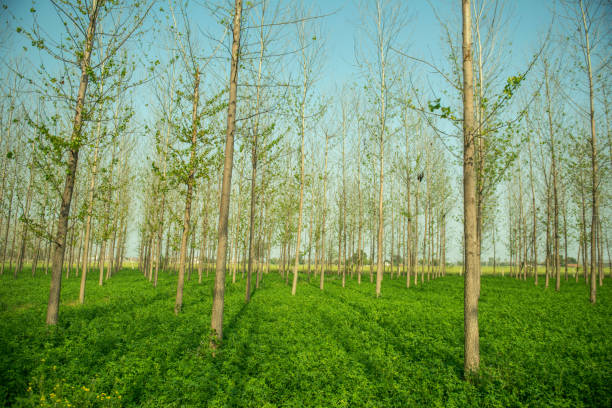

Agroforestry is a land management practice that combines the cultivation of crops and trees on the same piece of land. It can take many forms, including intercropping, alley cropping, and silvopasture, and it can be practiced on a range of scales, fr Read more
Trending
Trees for Corporates
What is Agroforestry and how it is helpful in fighting climate crisis?
Agroforestry is a land management practice that combines the cultivation of crops and trees on the same piece of land. It can take many forms, including intercropping, alley cropping, and silvopasture, and it can be practiced on a range of scales, from small farms to large plantations.
Agroforestry has several potential benefits, including:
-
Increased carbon sequestration: Agroforestry systems can help to sequester carbon dioxide from the atmosphere, as trees and other perennial plants absorb and store carbon in their wood, leaves, and roots. This can help to mitigate the impacts of climate change, as increased atmospheric CO2 is a major contributor to global warming.
-
Improved soil health: Agroforestry systems can help to improve soil health by providing cover, adding organic matter, and increasing soil water-holding capacity. This can lead to increased crop yields and reduce the need for chemical fertilizers and pesticides.
-
Biodiversity conservation: Agroforestry systems can provide habitat for a wide range of species, including birds, insects, and mammals. This can help to support biodiversity and maintain ecosystem functions.
-
Enhanced water management: Agroforestry systems can help to regulate water flow and reduce erosion, as trees and other vegetation intercept and slow the movement of water. This can help to prevent soil degradation and protect against flooding and landslides.
-
Increased income and food security: Agroforestry can provide farmers with a range of products, including timber, fuelwood, non-timber forest products, and food. This can help to diversify their income streams and increase food security.

Agroforestry can provide several benefits to rural communities, including:
-
Economic benefits: Agroforestry can provide a range of products that can be sold or used by the community, including timber, fuelwood, non-timber forest products, and food. This can help to diversify income streams and increase economic stability for households and communities.
-
Improved food security: Agroforestry systems can provide a source of food for communities, including fruits, nuts, and vegetables. This can help to increase food security and reduce reliance on imported food.
-
Enhanced environmental health: Agroforestry systems can help to protect and restore the environment, including soil, water, and biodiversity. This can help to improve the overall health and well-being of communities.
-
Increased social capital: Agroforestry can foster a sense of community and cooperation, as it often involves collective planning and management of land and resources. This can help to build social capital and strengthen community ties.
-
Improved education and training: Agroforestry can provide opportunities for education and training, including learning about sustainable land use practices and the value of natural resources. This can help to build knowledge and skills within communities.
There are several types of agroforestry systems, including:
-
Intercropping: This involves growing trees and crops together in the same field. The crops can be planted around the trees, or the trees can be interspersed among the crops.
-
Alley cropping: This involves planting rows of trees or shrubs alongside rows of crops. The crops are typically grown in the alleys between the rows of trees or shrubs.
-
Silvopasture: This involves integrating trees and pasture for grazing animals, such as cows or goats. The animals can graze under the trees, and the trees can provide shade and protection from the elements.
-
Homegardens: This type of agroforestry involves growing a diverse mix of crops, trees, and animals in a small area surrounding a house. Homegardens are common in tropical and subtropical regions and can provide food, fuel, and other products for households.
-
Agroforestry in forestry plantations: This involves integrating trees with other crops or animals within forestry plantations. This can help to diversify income streams and enhance the environmental and social benefits of plantations.
-
Urban agroforestry: This involves incorporating trees and other plants into urban and peri-urban areas, including in gardens, parks, and along streets. Urban agroforestry can help to improve air quality, reduce heat island effects, and provide other environmental and social benefits.
You may also like
Corporate Plantations
Most Popular
Connect with us
-
👥 Corporates
If you are looking for:
- 🌲 Tree Plantation Events
- 📊 CSR Projects
📧 corporate@growbilliontrees.com
📞 +91 9699723523
💬 +91 9325931304 WhatsApp (Only)
🕒 Mon - Sat | 10am - 7pm IST
-
🧩 Tree Plantation NGOs
If you are looking for:
- 💰 Financial Assistance
- 🤝 Operational Support
📧 support@growbilliontrees.com
📞 +91 9699723523
💬 +91 9325931304 WhatsApp (Only)
🕒 Mon - Sat | 10am - 7pm IST
-
🌼 Individuals
If you are looking for:
- 👥 Group Tree Plantation Drive
- 🌳 Bulk Tree Plantation
📞 +91 9699723523
💬 +91 9325931304 WhatsApp (Only)
🕒 Mon - Sat | 10am - 7pm IST





















